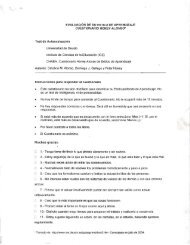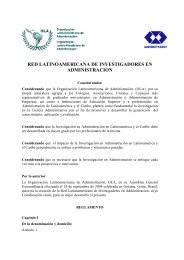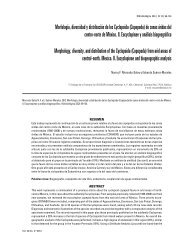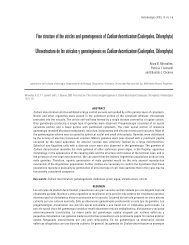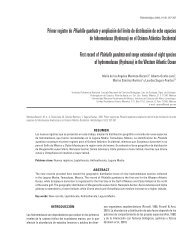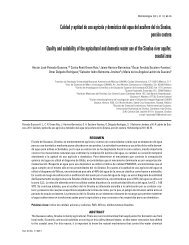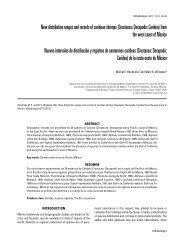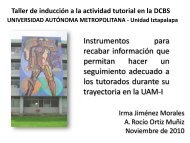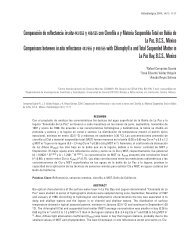Notes on some alpheid shrimps (Decapoda: Caridea) of Thalassia ...
Notes on some alpheid shrimps (Decapoda: Caridea) of Thalassia ...
Notes on some alpheid shrimps (Decapoda: Caridea) of Thalassia ...
You also want an ePaper? Increase the reach of your titles
YUMPU automatically turns print PDFs into web optimized ePapers that Google loves.
<str<strong>on</strong>g>Notes</str<strong>on</strong>g> <strong>on</strong> <strong>alpheid</strong>s from Mexican Caribbean 225<br />
McDermott, 1980: 1270; Rodríguez, 1980: 144, fig. 41a-d; Martínez-<br />
Iglesias et al., 1997: 423, fig. 11; Christ<strong>of</strong>fersen, 1998: 358; Escobar-<br />
Bri<strong>on</strong>es & Villalobos-Hiriart, 2003: 108; McClure, 2005: 139 (part.,<br />
not fig. 13).<br />
Alpheus cf. floridanus. Almeida et al., 2007: 12.<br />
Crang<strong>on</strong> floridanus. Schmitt, 1935: 144; Pearse, 1950: 150.<br />
Material examined: Bahía de la Ascensión, 9 specimens,<br />
May 2002; 1 specimen, January 2003. Bahía del Espíritu Santo, 1<br />
specimen, May 2001. Mahahual reef lago<strong>on</strong>, 19 specimens, July<br />
1997.<br />
Distributi<strong>on</strong>: Western Atlantic from southeast <strong>of</strong> Cape Hatteras<br />
(35°01.5’N, 75°30.8’W), North Carolina (Herbst et al., 1978);<br />
Bermuda (Markham & McDermott, 1980); Dry Tortugas, Florida<br />
throughout the Gulf <strong>of</strong> Mexico (Christ<strong>of</strong>fersen, 1979, 1998); West<br />
Indies from Bahamas to Curaçao and B<strong>on</strong>aire (Christ<strong>of</strong>fersen,<br />
1979); Mexico: Bahía de la Ascensión, Quintana Roo (Chace, 1972)<br />
and north <strong>of</strong> Mahahual (Escobar-Bri<strong>on</strong>es & Villalobos-Hiriart,<br />
2003); south to Rio Grande do Sul, Brazil (Christ<strong>of</strong>fersen, 1998).<br />
Actually the records <strong>of</strong> A. floridanus from the eastern Atlantic and<br />
eastern Pacific refer to closely related species (Anker, 2001; Williams<br />
et al., 2001; Almeida et al., 2007).<br />
Ecological notes: Bottoms with calcareous algae, am<strong>on</strong>g<br />
hydrozoans and bryozoans (Christ<strong>of</strong>fersen, 1979); in s<strong>of</strong>t muddy<br />
sediments in mangroves, estuaries and coastal lago<strong>on</strong>s (Christ<strong>of</strong>fersen,<br />
1979, Martínez-Iglesias et al., 1997). Shallow-water to 240<br />
m (Escobar-Bri<strong>on</strong>es & Villalobos-Hiriart, 2003), <strong>on</strong> sand and mud<br />
bottoms with <strong>Thalassia</strong>, 0.5-1 m depth (present study).<br />
Local new records: Bahía del Espíritu Santo, Quintana Roo.<br />
Remarks: Alpheus floridanus form also a species complex,<br />
with four species in the western and eastern Atlantic and eastern<br />
Pacific (see Anker, 2001; Almeida et al., 2007). On the basis <strong>of</strong> a<br />
phylogenetic analysis, Bracken et al. (2007) menti<strong>on</strong>ed the existence<br />
<strong>of</strong> at least five different species within this complex when<br />
populati<strong>on</strong>s <strong>of</strong> the eastern Pacific, western Atlantic and Gulf <strong>of</strong><br />
Mexico were compared.<br />
Alpheus cf. packardii Kingsley, 1880<br />
Alpheus packardii. De Grave et al., 2006: 1421-1422.<br />
Crang<strong>on</strong> packardii. Schmitt, 1935: 144.<br />
Alpheus normanni Kingsley 1878 . Chace, 1972: 68; Christ<strong>of</strong>fersen,<br />
1979: 322; Williams, 1984: 97, fig. 66; Bauer, 1985: 152; Martínez-Guzmán<br />
& Hernández-Aguilera, 1993: 615; Martínez-Iglesias<br />
et al., 1997: 424, fig. 13; Christ<strong>of</strong>fersen, 1998: 359; Bri<strong>on</strong>es-Fourzán &<br />
Lozano-Álvarez, 2002: 200; McClure, 2005: 145, fig. 17, pl. 3, fig. A.<br />
Material examined: Bahía de la Ascensión, 40 specimens,<br />
May 2002; 1 specimen, January 2003. Bahía del Espíritu Santo, 3<br />
specimens, May 2001. Mahahual reef lago<strong>on</strong>, 573 specimens, July<br />
1997.<br />
Distributi<strong>on</strong>: Listed as A. normanni from Bermuda; around<br />
Cape Charles, Virginia (Williams, 1984) to Key West Florida and<br />
Texas (Christ<strong>of</strong>fersen, 1979); throughout the Gulf <strong>of</strong> Mexico to Isla<br />
Pérez, Arrecife Alacrán, Yucatán (Martínez-Guzmán & Hernández-Aguilera,<br />
1993); Isla Cozumel and Bahía de la Ascensión,<br />
Quintana Roo (Chace, 1972; Bri<strong>on</strong>es-Fourzán & Lozano-Álvarez,<br />
2002); to São Paulo, Brazil (Christ<strong>of</strong>fersen, 1998); West Indies from<br />
Bahamas (Christ<strong>of</strong>fersen, 1979) to Tobago (Chace, 1972).<br />
Ecological notes: Am<strong>on</strong>g coral reefs (Chace, 1972), <strong>on</strong> sand,<br />
mud, broken shells, algae and sp<strong>on</strong>ges (Christ<strong>of</strong>fersen, 1979) and<br />
meadows <strong>of</strong> T. testudinum (Bauer, 1985). Subtidal to 73 m (Chace,<br />
1972), collected <strong>on</strong> sand bottom covered with T. testudinum, depth<br />
0.5-1 m (present study).<br />
Local new records: Bahía del Espíritu Santo and Mahahual<br />
reef lago<strong>on</strong>, Quintana Roo.<br />
Remarks: Alpheus packardii form also is a species complex,<br />
with at least three probable cryptic species in the western Atlantic,<br />
and two in the eastern Pacific (Almeida et al., 2007). Chace<br />
(1937) c<strong>on</strong>sidered the eastern Pacific species A. normanni and<br />
the western Atlantic A. packardii as syn<strong>on</strong>yms. Kim and Abele<br />
(1988) compared specimens <strong>of</strong> A. normanni from the eastern Pacific<br />
with material from Florida and find that the male specimens<br />
from the eastern Pacific presented the minor chela <strong>of</strong> the first pereiopods<br />
more el<strong>on</strong>gated than the minor chela <strong>of</strong> male specimens<br />
from Florida; therefore, the eastern Pacific form was c<strong>on</strong>sidered<br />
by those authors as a different species from the Atlantic form and,<br />
according to Christ<strong>of</strong>fersen (1998) the western Atlantic specimens<br />
previously named as A. normanni must be attributed to A. packardii.<br />
The minor chela <strong>of</strong> 50 males examined in the present study<br />
ranges from 3.64 to 4.38 times as l<strong>on</strong>g as broad, compared to 5.8<br />
reported by Kim & Abele (1988) for A. normanni from the eastern<br />
Pacific, so, we c<strong>on</strong>cluded that the specimens examined bel<strong>on</strong>g to<br />
the A. packardii species complex.<br />
Alpheus viridari (Armstr<strong>on</strong>g, 1949)<br />
Crang<strong>on</strong> viridari. Armstr<strong>on</strong>g, 1949: 8-12, fig. 2.<br />
Alpheus viridari. Chace, 1972: 73; Carvacho, 1979: 455;<br />
Markham & McDermott, 1980: 1270; Martínez-Iglesias et al., 1997:<br />
424, fig. 17; Alvarez-León, 2003: 265; McClure, 2005: 155, fig. 23;<br />
Hernández-Ávila et al., 2007: 37.<br />
Material examined: Bahía de la Ascensión, 1 specimen, May<br />
2002. Mahahual reef lago<strong>on</strong>, 4 specimens, July 1997.<br />
Distributi<strong>on</strong>: Western Atlantic: Bermuda (Markham & McDermott,<br />
1980); Florida Keys to Trinidad and Curaçao (Chace, 1972);<br />
Isla Cozumel and Bahía de la Ascensión, Quintana Roo, Mexico<br />
Vol. 20 No. 3 • 2010



